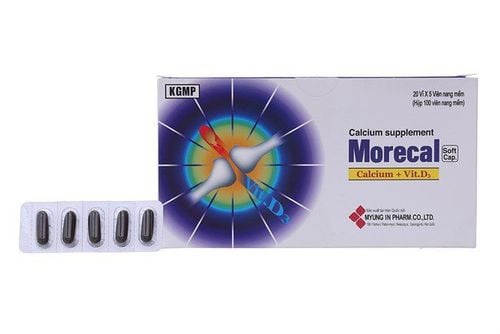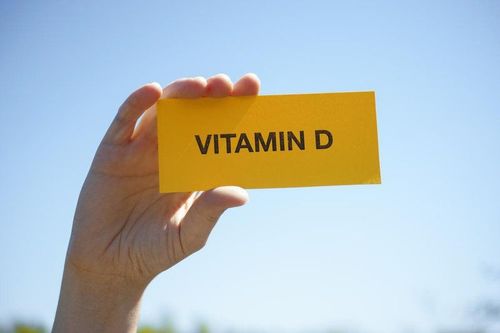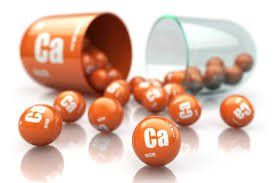This is an automatically translated article.
The article was professionally consulted by Specialist Doctor II Le Thanh Cam - Department of Pediatrics - Neonatology, Vinmec Da Nang International General Hospital.Vitamin D plays an important role in the metabolism and absorption of calcium and phosphorus for bone structure. Consequences of vitamin D deficiency in young children will reduce the absorption of calcium and phosphorus in the intestines, the body must mobilize calcium from the bones into the blood, causing disturbances in the calcification process in the bones, causing osteoporosis and rickets in children.
1. What phenomenon will children with vitamin D deficiency have?
Signs of bone changes can appear several months after vitamin D deficiency. Babies born to mothers with soft bones may develop rickets within 2 months of birth.1.1. Early signs Including early signs of the nervous system such as:
The child is often fussy, has trouble sleeping, has trouble sleeping, sleeps or is startled due to nervous stimulation; Profuse night sweats, even in cold weather (thick sweats); The child has hair loss on the nape of the neck (licking sign); Children often have delayed physical development, decreased muscle tone (muscle), blue skin, enlarged spleen; Wheezing due to soft laryngeal cartilage - the muscles spasm causing the child to vomit, hiccup, or leak stool and urine. 1.2. Late signs The manifestations of bone disorders vary depending on the bone position, the age of the child and the severity of the disease:
Slow teething and unbalanced teeth, slow to roll, crawl, walk.. .; Wide fontanelle, soft fontanelle, long-lasting fontanel; In the bones, there is skull deformity, the skull is soft and concave (signs of craniosynostosis). The fontanelle is hollow, the joint grooves are enlarged, the head is easily deformed, the head is flat behind or on one side due to the lying position; Cranial tumor, usually in the forehead and parietal region; The head of the carpal bone is large, enlarged into a "wrist"; Rib chain and thoracic deformity, bow legs, scoliosis; May have convulsions due to hypocalcemia. Rickets is a primary disease in young children who will see their legs deformed and slow in physical development. Bone deformities in childhood can leave sequelae to adulthood, the spine can be hunched, crooked, and narrow in the pelvis.
2. What disease does vitamin D deficiency cause in children?

Khi cơ thể của trẻ bị thiếu vitamin D có thể dẫn tới làm tăng nguy cơ mắc các bệnh tim mạch
2.2. Asthma Vitamin D deficiency affects lung function and makes asthma worse, especially in children. Vitamin D may improve asthma by blocking inflammatory proteins in the lungs, as well as increasing the production of a protein that has anti-inflammatory effects.
2.3. Cardiovascular disease When a child's body is deficient in vitamin D, it can lead to an increased risk of cardiovascular diseases such as high blood pressure, and an increased risk of death from this disease.
2.4. Allergies Children who are not getting enough vitamin D are more likely to develop food allergies.
2.5. Influenza Several studies show a link between vitamin D deficiency and respiratory infections. People with low vitamin D levels are more susceptible to illnesses like colds and flu than people with high levels of vitamin D in the body.
2.6. Oral health Vitamin D is needed to absorb calcium and phosphorus - nutrients needed for bone growth. Vitamin D controls calcium levels in the blood, intestines, and bones. Therefore, vitamin D deficiency can lead to weaker tooth enamel. Several recent reports suggest a link between oral health and vitamin D. People with low vitamin D levels have a higher rate of tooth loss than those with high vitamin D levels.
3. What to do when vitamin D deficiency?
To determine if your child has a vitamin D deficiency, the doctor will order a simple blood test. The doctor can then advise the baby if vitamin D supplements are necessary. Note that there is no uniformity in vitamin D levels for each child because vitamin D levels depend on health conditions, age, ... of each child.4. Prevention of vitamin D deficiency in children

Đối với bé dưới 6 tháng tuổi: Nên cho trẻ tắm nắng và tốt nhất là để trẻ được bú sữa mẹ
When realizing that a child has signs of vitamin D deficiency, parents can take the child to a reputable hospital specializing in pediatrics such as Vinmec Times City International General Hospital for advice and treatment.
In addition to dietary supplements, parents can give their children support foods containing vitamin D and essential micro-minerals such as zinc, lysine, chromium, selenium, ... to help fully meet their needs. nutritional needs in children. At the same time, these essential vitamins also support digestion, enhance nutrient absorption, help improve anorexia, and help children eat well.
>> Parents can learn more: MSc Vitamin D and infection resistance. Dr. Vo Khac Khoi Nguyen - Department of General Surgery - Vinmec Central Park International General Hospital.
Please regularly visit Vinmec.com website and update useful information to take care of your baby and family.










![[Video] How to take care of children in summer?](/static/uploads/small_20190730_112639_927206_cham_soc_tre_mua_he_max_1800x1800_png_7a3b48f9f3.png)



